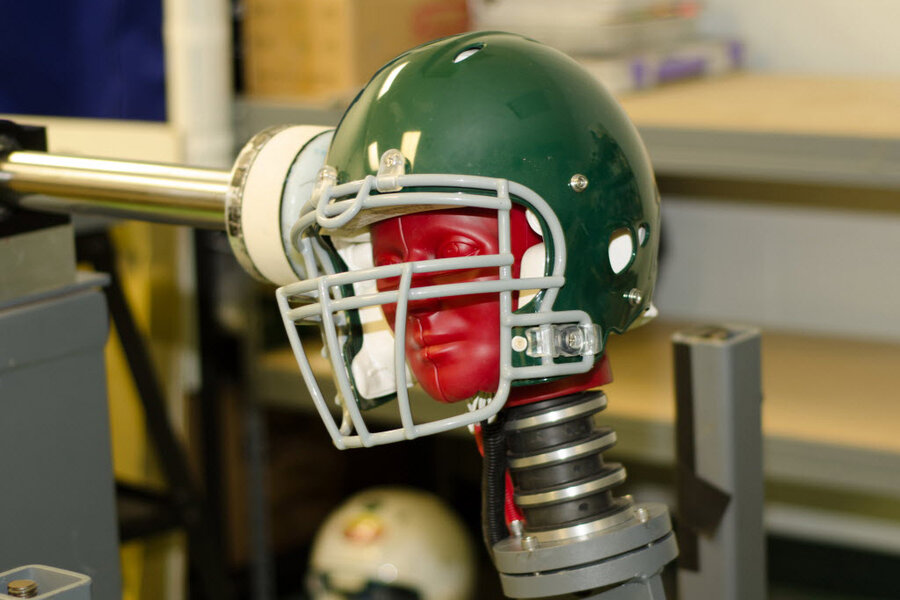California moves to limit school football injuries. But is the sport fixable?
Loading...
| Los Angeles
California just opened the Pandora’s Box labeled “fixing football” a tad further this week by enacting a law limiting physical contact in middle and high school football practice to three hours a week. And that’s only during the actual season. Out of season, it’s nix on the tackle time during any scheduled practices.
These moves are in response to a growing concern among parents and former NFL players about the long-term damage done by concussions and other impact-related injuries. The Golden State joins a list of 19 other states that have placed some form of limit on the time youngsters can practice bashing into one another. The list includes Texas, where football is the unofficial state sport.
But as more voices are heard on the issue, disagreement over the most effective way to address contact-related injury is also growing.
“Football is inherently risky,” says Dr. Pietro Tonino, former assistant team physician to the then-Los Angeles Rams and chief of sports medicine at Loyola University in Chicago. Limiting practice time may actually make the sport riskier, he says, “because once the kids are in a game, they have had less time assimilating the moves they need to keep themselves from getting injured.”
Dr. Tonino has four children, two boys and two girls. He says he made his decision about football and children some 15 years ago. “I knew they were just not going to play the game at all,” he says, “and neither of my sons play the game.”
Fellow parent and physician Alex Powers, however, has taken a different approach. Both his sons play football. They even participated in a study sponsored by Wake Forest Baptist Medical Center, where Dr. Powers is a pediatric neurosurgeon. The recent study found that limiting contact during practice did not decrease the amount of contact during game play. But, says Powers, who is a co-author, “limiting the practice time did significantly cut back on injuries sustained during practice.”
This finding is important, says Powers, because more injuries occur during practice than during games.
“Football is not going away any time soon,” says Powers, adding that it is in everyone’s interest to do whatever can be done to make if safer.
Youth participation in football is down, however, notes Dan Lebowitz, executive director of the Center for the Study of Sport in Society at Northeastern University in Boston. If professional football wants to have the kind of robust network of young players funneling up through the various levels that it has traditionally relied upon, he notes, “it will have to change.”
The center is in the midst of a year-long study devoted to answering the question of where the best middle ground lies, notes Mr. Lebowitz. “How do we reduce the risks of traumatic injury without losing the athleticism, the grace, and the character-building that go along with sports in our culture?” he asks.
However, not everyone is devoted to saving the sport, says Irv Muchnick, author of “Concussion, Inc.: The End of Football As We Know It,” a collection of his investigative reporting on the unfolding crisis inside the NFL,which will be published this fall. He dismisses the legislative action as window dressing for a fundamental problem.
“Football is about violent collision, just as boxing is about punching,” he says via e-mail.
More important, notes Mr. Muchnick, he suggests the California law, which goes into effect on Jan. 1, is a halfway measure that will neither change the nature of the game nor protect children from injury.
“These allow football’s private profiteering interests to default on the real but hidden costs of their enterprise, which inevitably get absorbed by the public sector,” he says.
Every society chooses the kind of entertainment it wants and is willing to pay the price for, says Muchnick. “Football is what it is: not fixable.”
For the sake of such values and goals as academic achievement, reduction of violent crime, and improved lifelong workforce productivity, Muchnick says the football industry must be drastically downsized.
In particular, he adds, “public high schools should not be stuck with footing the medical and insurance and ancillary social bills, all in the name of entertaining their communities and serving as a developmental talent system for the professional college and NFL levels.”







